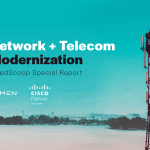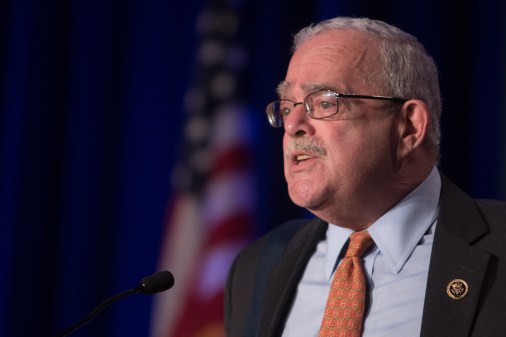More attention from Congress could lead to smoother EIS transition

The House Oversight and Reform Committee recently added a new category under its biannual FITARA Scorecard: It grades agencies’ progress in transitioning to the $50 billion Enterprise Infrastructure Solutions (EIS) network modernization contract — and away from predecessor vehicle Networx.
On the surface, it was a small gesture. The data was already being collected by the General Services Administration and made publicly available. And new categories are added to the scorecard pretty regularly. The transition to EIS is just one of now nine components on which the committee will score agencies’ IT acquisition and management “hygiene” via the scorecard, which was originally a measure of federal compliance with statutes in the Federal IT Acquisition Reform Act.
While simple, scorecards have the power to focus people’s attention on progress toward a goal. And in the case of the FITARA Scorecard, it’s been successful in bringing focused oversight to some of the most pressing challenges in federal IT management.
Carol Harris, director of IT and cybersecurity for the Government Accountability Office, saw it happen with software licensing under the MEGABYTE Act. The Oversight Committee added agencies’ progress complying with the 2016 law and its requirements to inventory software licenses on the fourth iteration of the scorecard in 2017.
“By far, the vast majority of agencies had an F grade,” Harris said of software licensing on that first scorecard.
But just a few years later, all but one agency had an A grade in the category on the latest scorecard this past summer.
“I really give that committee a lot of credit, because had they not put software licensing as part of the scorecard, we very likely could still have very limited progress in that area,” Harris told FedScoop.
Harris hopes that the same kind of attention from Congress on EIS can move agency officials to act more quickly around their network and telecom modernization. Her agency has been following the transition closely in recent years and found that — while agencies may not be in as bad of shape transitioning to EIS as they were inventorying their software licensing several years ago — “the bottom line is that agencies are behind schedule. And, unfortunately, if they continue the course that they’re on, we will likely repeat history with another delayed [telecom contract] transition and potentially hundreds of millions of dollars in savings.”
“So I’m hopeful that having EIS as part of the scorecard will also generate that kind of motivation for the agencies to really focus on it and be able to accelerate the progress that’s necessary to be able to be in a position where they’re there on time with their transition,” she said.
Matthew Cornelius, the executive director of the Alliance for Digital Innovation and a former adviser to the Federal CIO, also recognizes the power of good oversight, both from Congress and his former employer, the Office of Management and Budget.
In agencies’ slow start transitioning to EIS, “I think OMB and Congress, in particular from an oversight standpoint, did not get engaged as early and as aggressively as they as they could have or should have,” Cornelius told FedScoop. But he commended the Oversight Committee and Rep. Gerry Connolly, D-Va., the chair of the Subcommittee on Government Operations, for holding a hearing on EIS progress early this year and adding it as a new category on the scorecard. With that, “there will be a regular and important marker for oversight when it comes to how agencies are doing on EIS,” he said.
“Where OMB and I think Congress increasingly can have a stronger role is better oversight and ensuring agencies are not just taking the easy path out,” Cornelius said. “It’s one thing to say that EIS is a vehicle for transformation. It’s another thing to ensure that the oversight bodies, the technical teams in agencies, the senior political leadership in agencies, that they all agree that it’s better to leverage EIS and to sort of build some stretch goals out and really try to get there.”
GSA, the agency responsible for facilitating the EIS contract and providing guidance on how agencies should transition, has done a solid job in its role, said Cornelius. But the agency can only do so much. “It takes some real commitment from agency leadership, from the OMBs of the world, and from Congress making this a priority to ensure that folks don’t just move, but that they get the real benefits of sort of what the networks of the future look like for federal agencies,” Cornelius said.
Challenges and opportunities in presidential transition, COVID-19
The added oversight comes at a time when agencies just might need it the most, facing certain leadership changes during the upcoming presidential transition and the lingering effects of the COVID-19 pandemic.
Even without these major events, the transition from the legacy Networx contract to the more transformational EIS is a difficult thing for agencies to manage, said Alan Chvotkin, executive vice president and counsel of the Professional Services Council.
“This is not a telecom contract in and of itself, and it presents such a wide menu of choices for federal agencies,” Chvotkin said. “Whereas Networx, you know, it was really a successor contract — it was a little bit more like-for-like in technology upgrades. But this [EIS] is a whole different technology review and opportunity. So that presents a little bit more of a challenge for agencies and a little bit more of a challenge for vendors who are competing for those task orders.”
Agencies are tasked with the challenge of looking into the future and predicting the network and communications tech they’re going to need for the next decade or so. Add in recent budget austerity, and you can see the difficult role CIOs have to play with EIS, Chvotkin said.
A presidential transition will almost certainly complicate the process. It happened when the Trump administration came in in 2017 and “reset the markers,” with an emphasis on modernization success instead of the early focus on urgency that the Obama administration had built into the contract since 2014, Cornelius said. And it’s something that could happen again.
He gives agencies credit for this as a possible explanation for why they may have moved more slowly in their transitions to EIS. “It’s better to do it smartly, I think, than to do it swiftly,” Cornelius said.
But the incoming Biden administration could also work strategically to make EIS one of its early IT wins if it focuses on “moving agencies to this sort of the future of their kind of network architecture” under the new contract, Cornelius said. “And so making sure that the budget reflects that, making sure that Congress — not just the authorizers but the appropriators — understand the upfront needs to sort of manage the transition, and to get buy-in from the new politicals on the Biden team.”
In the meantime, Chvotkin said, EIS progress could stall as “decision-makers are probably unwilling to make decisions, or if they’re willing, they’re subject to being reversed.”
Meanwhile, the COVID-19 pandemic has shown just how important modern network and communications technology is to government operations.
“I would imagine there’s a lot of agencies who have completely sort of reoriented their mindset around how they can leverage EIS for modernization and transformation because of how they’ve seen the workforce and their workflows shift over the past 10 months,” Cornelius said.
And while many agencies continue to face the novel stresses of the crisis, the deadlines to transition to EIS haven’t shifted.
“I think that that makes it so much more important for Congress to keep their eye on this program and how the agencies are doing,” Harris said. “And I think that including that as part of the FITARA Scorecard, that was a really effective thing, an effective oversight move on their part so that the agencies understand that when the House Oversight and Reform Committee hold their hearing on FITARA and they see that scorecard and EIS is part of that scorecard, they’re going to pay attention to it.”
This story is part of a FedScoop special report on the Network and Telecom Modernization. Read the rest of the report.

This story was featured in FedScoop Special Report: Network + Telecom Modernization - A FedScoop Special Report






